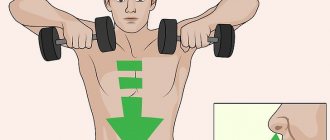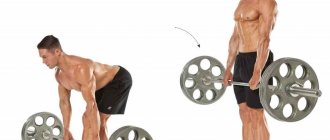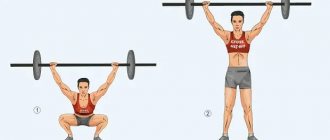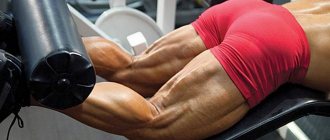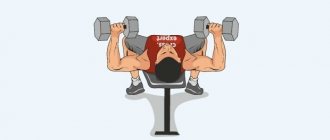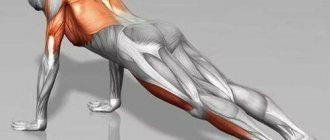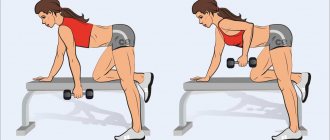Fitness and BodybuildingTips and Tricks
Perfect your delt workout and build a bigger core by comparing two powerful shoulder exercises: the dumbbell overhead press and the barbell press.
Author:
Brad Borland
Large, defined deltoids can really set you apart from your peers when showing off your powerful muscles. Shoulder width is a direct indicator of power, strength and excellent physical condition. Like any avid athlete, your main goal is to get the most out of all the sweat, sacrifice, and hard work you put in tirelessly in the gym. Really, what's wrong with getting the most out of your efforts?
The overhead press, lateral raises, barbell rows and shrugs are all well-known training tools and essential exercises for anyone who wants to realize their dream of massive deltoids. But what about choosing the most effective exercise for developing deltoids? The overhead press is the patriarch of all deltoid builders with many variations and techniques; the exercise promotes rapid mass growth and at the same time improves results in other bench presses. The two most common overhead presses are the seated dumbbell press and the seated barbell press. Each has unique strengths, but we want to break these basic lifts down into simple factors and see which exercise takes the top step of the podium.
Technique for performing dumbbell and barbell bench presses while sitting
Let's look at how the seated press exercise is performed using each apparatus.
Let's start with dumbbells. This exercise is performed as follows: the athlete sits on a training bench, leaning his back completely against it. Takes two dumbbells of the appropriate weight in his hands, then brings them to his shoulders (palms facing forward), and, slowly inhaling air, smoothly lifts both dumbbells at the same time until his arms are completely straightened at the elbows. Then he lowers the projectiles just as smoothly, exhaling air.
When performing this exercise, a common mistake is to move your back away from the training bench. In this case, the load is redistributed on the upper body and the shoulders are worked to a lesser extent.
Expanding the question of which is better - a barbell or dumbbell bench press while sitting, let's now consider the use of a barbell. As in the first case, the athlete sits on a bench with a backrest and leans completely against it. Takes the barbell by the bar so that your hands look up, while the grip should be slightly wider than shoulder width. Having removed the barbell from the supports, the athlete fixes it on his chest and, drawing air into his chest, lifts it above his head until his arms are fully straightened. Having fixed the position for 2 seconds, then he smoothly lowers the projectile, exhaling air.
A common mistake when performing this exercise is exactly the same as when using dumbbells, so you must constantly ensure that your entire back is in full contact with the bench. In addition, athletes sometimes throw their heads back, this is also wrong. The gaze should look straight.
Useful tips
The following tips will help you get the most out of the exercise and avoid injury:
- the grip is chosen such that the angle between the shoulder and forearm is straight at the lowest point of the trajectory;
- you need to direct your gaze forward, for which you choose a point in front of you (on the wall), which you look at during the entire exercise;
- in order to control the trajectory of the barbell, at first it is advisable to perform the exercise in front of a mirror (lateral projection);
- to support the lower back, when moving to medium and heavy weights, it is necessary to use a weightlifting belt;
- For the same purpose, you can use the bar located on the stand of the bench press. The middle of the back is leaned against it;
- the arms are not fully extended at the top point: the elbow joint is slightly bent;
- for those who have problems with the rotator cuff muscle, it is not recommended to perform a barbell bench press while sitting with the apparatus behind the head (do it from the chest);
- keep your back straight throughout the training;
- lifting and lowering the weight is carried out without jerking - smoothly and controlled;
- use the entire range of motion available to the barbell;
- below and above do not rest.
If you follow all the recommendations, you don’t have to think about technique – you’ll do the barbell bench press while sitting, you’ll do it right.
What muscle groups work?
As is clear from the exercise technique described above, the entire load falls on the muscles of the upper body. In the case of the seated dumbbell press and the seated barbell press, the work involves essentially the same muscle fibers. In particular, the main load falls on the shoulders, upper body (trapezius and pectoral muscles), as well as the triceps. At the same time, the lower back and abdominal press are practically not loaded.
Anatomical atlas
Of course, it loads many muscle groups, therefore, it refers to multi-joint training:
- the load is directed mainly to the anterior bundles of the deltoid muscle;
- synergists here: serrated anterior muscles, triceps, lower and middle trapezius, supraspinatus, lateral deltas;
- the dynamic stabilizer is the long head of the triceps;
- the muscles responsible for raising the shoulder blades and the top of the trapezius act as stabilizers.
At the same time, the biceps, large and pectoral muscles work, and the abs are loaded.
The view of the anatomical atlas can be seen in the picture below:
Difference #1: Proportional load
From the above, we can conclude that there is no difference whether you perform a dumbbell bench press while sitting or use a barbell. However, this opinion is erroneous. There is a difference and it lies in the fact that using dumbbells works the muscles on both sides of the body better than using a barbell.
This fact is connected with the fact that the right and left sides of a person are not symmetrical, and one of them is stronger and more developed than the other. When an athlete practices barbell bench press, our body redistributes the overall load in such a way that the stronger side receives more weight, which, in turn, further increases the difference between the sides. Therefore, you can often see that athletes who only train with barbells have their right (right-handed) arm more pumped up than their left.
When using dumbbells, this does not happen, and the weak side receives exactly the same load as the strong side, thereby developing the whole body symmetrically and proportionally.
What to choose for bench press
To develop the pectoral muscles, there is nothing better than a barbell and the ability to increase working weight! Yes, dumbbells allow you to “deeply” and concentratedly work the pecs, perform flyes and pullovers, but their weight range is negligible. Therefore, in the end, progress will be stopped due to the inability to use more weight of shells.
Difference No. 2: range of motion and safety of the exercise
Load proportionality is not the only difference between bench pressing a barbell or dumbbells on an incline or even a flat bench.
When using dumbbells, the range of movements of the limbs turns out to be greater than when working with a barbell, since the left hand is not constrained by the movements of the right. In turn, a larger amplitude allows you to work a larger number of muscles that are practically not involved in the barbell press. In addition, when working with dumbbells, the so-called stabilizing muscles are activated. When using a barbell, they are in a “sleeping” state, since the bar acts as a stabilizer.
Speaking about the dumbbell shoulder press, we note that from a safety point of view, this exercise also wins the duel over the barbell press. So, if an athlete makes a mistake during his execution, the dumbbell simply falls to the floor. Sliding your hands off the barbell can have very unpleasant consequences.
What is better for broaching
It’s easier and more convenient to do stretching with a barbell, but if you consider the Olympic bar, then a significant drawback appears - this is an impressive minimum weight, which in training small muscles, such as deltoids, will not allow you to comfortably perform the movement. Pain or discomfort will lead to poor technique or even injury! The pull-up is an exercise that should be performed with dumbbells whenever possible.
Difference No. 3: development of strength and muscle volume
Based on the description of the previous points, we can conclude that when it comes to pressing dumbbells or barbells while sitting, preference should be given to the former. But it's not that simple. The fact is that only training with a barbell guarantees the development of strength and muscle volume. Dumbbells cannot do this. The reasons for this fact are the following:
- Using a barbell you can gain much more weight than using dumbbells, which means that the muscles in the first case will be pumped and developed more strongly.
- Since the dumbbell press involves more muscle groups than a similar exercise with a barbell, this leads to a “dispersion” of the total load.
Thus, heavier weights and fewer muscle fibers mean that the barbell press is more effective in terms of gaining lean mass than a similar exercise with dumbbells.
What is better for bent over rows?
Bent-over rows can be performed equally well with dumbbells or a barbell. As they say, it's a matter of habit. But if you consider all kinds of back exercises, for example, bent over rows with one arm, then dumbbells are still somewhat more functional than barbells. On the other hand, the barbell can be used as a “T” bar, resting one side of the bar against the wall, and lifting the other side using a belt and an improvised crossbar.
Exercises standing and sitting
As part of this topic, it is also useful to consider the standing or seated dumbbell press and a similar barbell press, which is known as the “military” press.
When performing an exercise while standing with any apparatus, the lower part of the body is automatically involved in the work. At the same time, the use of dumbbells involves a large variation and variety of exercises, for example, when lifting them, you can rotate the body, thereby loading the abdominal press in different ways. Exercises with a barbell in a standing position put more strain on the leg muscles due to a different technique and greater weights than in the case of dumbbells.
Thus, by performing both seated and standing dumbbell exercises, you will generally develop more upper body muscle fibers in a proportionate manner. But exercises with a barbell contribute to a more intense workout of large muscles and are indispensable when training the lower body.
Dumbbell bench press on a fitball[edit | edit code]
Dumbbell bench press on a fitball
Equipment
: ball, dumbbells.
Dumbbell bench press (variations)
Core muscles
: breast.
Additional muscles
: triceps and anterior deltoids.
Level of training
: elementary, intermediate.
THE CORRECT PRESS
Try not to connect or hit the dumbbells. In the lower phase during the start, do not push off the ball with your elbows, making the movement easier.
- Step 1'
. Starting position: lying on a fitball. Place your feet slightly wider than your shoulders. Hold dumbbells in bent arms at chest level with an overhand grip. - Step 2
. Exhale and lift the dumbbells up. - Step 3
. Return to the starting position.
This exercise is suitable both at the initial stage of training for more comfortable performance, and during recovery from injuries.
Correct solution
As can be seen from the above analysis, it is wrong to ask the question of which is better - the barbell or dumbbell bench press, since each exercise is good in its own way and serves specific purposes.
The right decision would be to include both type 1 and type 2 exercises in the athlete’s training program. So, having gained strength with the help of a barbell, it is necessary to emphasize the use of dumbbells in order to “pull up” the secondary muscles to the developed main muscle fibers. After this, return to training with a barbell again. This scheme holds the key to progress in the development of overall strength and muscle volume, which has been demonstrated more than once in the practice of weightlifting.
Verdict
Of course, the choice is entirely yours and is determined by your personal preferences, level of comfort and susceptibility to injury. Both options have practical applications in everyday life, but the barbell press will shift the focus to the front delts and maximum load, while the dumbbell press will promote a comprehensive development of the deltoid muscle with a greater emphasis on technical aspects and trajectory control.
You can easily integrate both exercises into your training program by including the barbell press on heavy, strength days, and leaving the dumbbell press for light, high-rep training on hypertrophy days. The choice is yours, but both options will serve you well.
Features of the training[edit | edit code]
The specifics of building a training plan with dumbbell presses depend on the level of the athlete and his overall goals.
Beginners[edit | edit code]
This is usually the second exercise given to beginners after push-ups. The exception is a person who has a symmetrical body and sufficient strength to immediately begin working with a barbell of half his weight. For a beginner, the dumbbell press will be your primary compound movement. It will be performed at the beginning of the workout and “take place” 2 times a week. This is necessary to gain movement skill. It is impossible to overload the joints and nervous system at this stage due to the fact that small weights are used. Work style - no more than 30 seconds under load, usually equivalent to 8-10 repetitions per set, with a minute of rest and 3-4 working approaches.
Middle level[edit | edit code]
Without learning to bench press a barbell on a straight bench. If a person’s goal is purely aesthetic, and he is not interested in heavy bench presses, after the initial strength gain, he is taught to bench press at an angle to ensure maximum pectoral hypertrophy. And the dumbbell press is given in the “second” or “light” workout, with the goal of working out muscle groups from different angles and more harmonious development. At the same time, the mesocycle takes not one week, like the professionals, but two. That is, two conditional “Mondays” are chest days, and on the first the athlete presses the barbell at an angle, and on the second he starts with dumbbell bench presses on a straight line.
Advanced level[edit | edit code]
Various options are allowed here - using the dumbbell press as a second exercise in your main chest workout, using it on a “light” day, adding it to supersets with “stretching” exercises like dumbbell flyes or push-ups with extremely wide arms.
Detailed technique for bench press with dumbbells[edit | edit code]
To take the starting position before the dumbbell press, you must lie on a bench, and your assistant must give you both dumbbells in turn. Or, you can take the starting position yourself, without outside help. Sit on the edge of a bench, holding dumbbells vertically on your hips near your torso. You need to make sure that you keep the dumbbells evenly centered. Keeping your elbows bent, tuck your chin toward your chest. Push the dumbbells toward you with your feet and lean back, keeping your back round. Keeping your forearms vertical, immediately begin pressing. During the press, your legs should be stable; place a block under them, as if you were doing a bench press.
Press the dumbbells in the same path as you would press a barbell: the bottom position is the same as for a barbell press, but perhaps having less of a horizontal component in the trajectory will allow you to maintain better control over the dumbbells. The dumbbells should move the same way. They should not “drift” to the sides, one hand should not get ahead of the other.
When pressing dumbbells, you can hold them differently than like a barbell. You can hold them parallel to each other or in any other way that is more convenient for you. You can even change the position of your wrists as you move. What makes dumbbells so convenient is that they allow you to hold your wrists in almost any position, unlike a barbell.
You should not strive for excessive amplitude in the dumbbell press. The distance between your hands should be approximately the same as when doing a barbell bench press. There is no need to do dumbbell presses with an overly wide grip, trying to lower your arms as low as possible at the lowest point of the amplitude. Lower your arms down no lower than you do when bench pressing.
For the first few workouts, use light dumbbells and don't go to failure. Wait until you learn to maintain complete control over the dumbbells. Only after this can you give your all to the exercise. You may have poor control of the dumbbells right now. But as you get more and more used to the exercise, your control over the dumbbells is bound to improve.
The assistant should kneel behind your head and keep their hands under your elbows. So he will be really ready to come to your aid. But don't do this exercise to failure. When you have one repetition left to failure, stop, otherwise you risk losing control of the dumbbells. Losing control can cost you serious injury. Even the most attentive assistant will not be able to do anything if, having reached failure, you suddenly lose control of both dumbbells at the same time.
An assistant (preferably if there are two) should remove the dumbbells from you at the end of the set. Or, you can stand up from the bench on your own, holding dumbbells in your hands. This is done like this: lower the dumbbells to the lower torso, without relaxing the muscles of the arms, shoulder girdle and chest, raise your bent knees as high as possible. When your thighs touch the dumbbells, tuck your chin to your chest and immediately “throw” your legs forward and roll into a sitting position. This is easier to do if your assistant places his hands on your shoulders and helps you roll over and sit up straight.
Typically, fixed weight dumbbells have a 2.5 kg increment. We multiply it by two dumbbells and get a total of 5 kg, which is a very large increase. Continue doing bench presses with a given dumbbell weight until you can easily do a few reps above your goal before moving on to heavier dumbbell weights. You should also not tie additional weight to your wrists, trying to make the transition from one dumbbell to another, heavier one, smoother. It is a bad idea. Weights tied to your wrists can cause you to lose your balance.
If you have collapsible dumbbells, you can add not 2.5 kg each, but less if you have small weights. Even if you only have fixed-weight dumbbells, you can attach small weights to each dumbbell. Use strong adhesive tape for this purpose and make sure that the weights are securely attached to the dumbbells. Over time, you will reach a weight equal to the fixed weight of the following dumbbells. To make it easier for you to balance and maintain control over the dumbbells, attach small weights equally to both ends of each dumbbell. There is an alternative option: you can use small pancake magnets.
